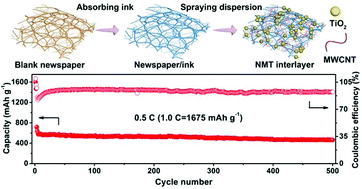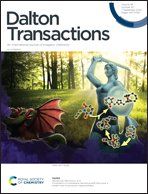A waste newspaper/multi-walled carbon nanotube/TiO2 interlayer for improving the cycling stability of lithium–sulfur batteries by anchoring polysulfides†
Abstract
Owing to the high theoretical specific capacity and energy density, lithium–sulfur (Li–S) batteries are considered an ideal candidate for next-generation rechargeable batteries. Whereas, the shuttle effect of polysulfides limits the utilization of active materials, reducing the electrochemical performance of lithium–sulfur batteries. Herein, by directly using waste newspapers as a substrate, a waste newspaper/multi-walled carbon nanotube/TiO2 (NMT) interlayer has been prepared for stable Li–S batteries. In the composite interlayer, the newspaper functions as the basic frame for loading materials. Carbon materials absorbed by the newspaper provide both a conductive pathway and physical adsorption of lithium polysulfides (LiPS). Meanwhile, TiO2 inhibits the dissolution of LiPS in the electrolyte by strong chemical bonding. The morphology and spectra prove that the newspaper plays a key frame role in the functional composite interlayer. The electrochemical analyses demonstrate that the as-fabricated interlayer can obviously improve the cycling performance of Li–S battery. At a 0.5 C (1.0 C = 1675 mA h g−1) charge–discharge current density, after 500 cycles, the Li–S battery with NMT interlayer still exhibits a discharge capacity of 463.7 mA h g−1 with a low capacity decay per cycle of 0.071%.



 Please wait while we load your content...
Please wait while we load your content...